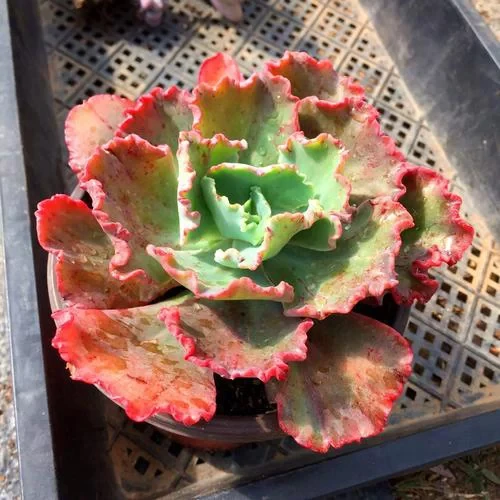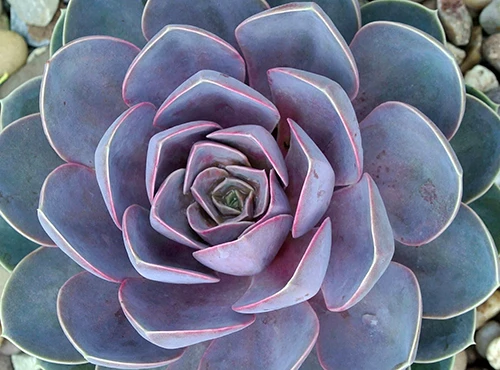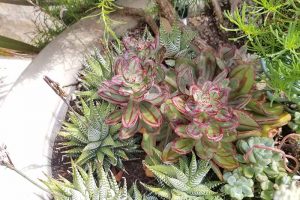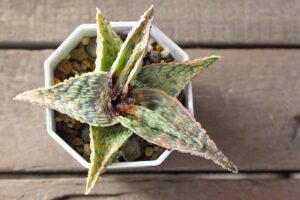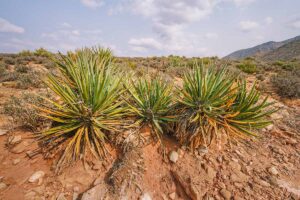Echeveria spp.
Colorful and ornamental, easy-care Echeveria species, hybrids, and cultivars are flowering succulents that thrive on neglect and arid conditions in the garden.
They can be raised as houseplants as well.
Highly valued for their unique, thick leaves, echeveria is widely bred and available in a range of handsome shades, from icy blue-greens to rich reds and purples.
In summer, particularly with outdoor cultivation, tall flower stalks shoot up and carry clusters of small, bell-shaped or starry flowers in shades of orange, peach, pink, red, white, and yellow.
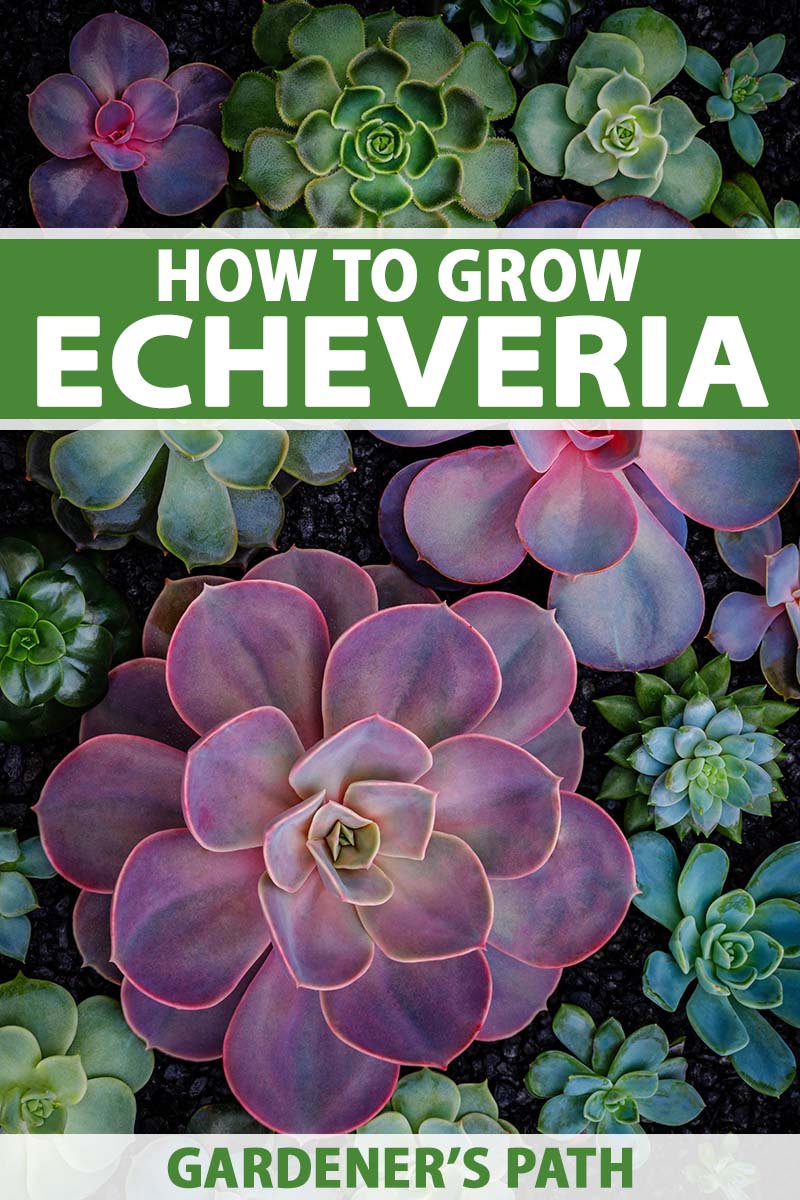
We link to vendors to help you find relevant products. If you buy from one of our links, we may earn a commission.
Plant sizes vary but these succulents are typically compact to moderate in size, and grow in lovely, symmetrical rosettes.
Native to semi-desert regions of the Americas, they make an excellent choice for mass planting in borders, carpet bedding schemes, containers, fairy gardens, rockeries, and xeriscape gardens.
But they’re cold tender and need a dry location to overwinter outdoors, or they can be brought indoors in areas with cold winters.
Easily cultivated with minimal water, is your garden ready for some colorful echeveria? Then let’s jump in to explore how to grow succulent echeveria plants.
Here’s what you’ll find ahead:
What You’ll Learn
What Is Echeveria?
Echeveria is a genus of approximately 150 species and hundreds of cultivars of evergreen perennials, ornamental flowering plants with thick, fleshy leaves and stems in loose or tight rosettes.

The many hybrids vary greatly in color, form, shape, and size depending on their parentage, with rosettes ranging in width from one to 20 inches, although most are well under 12 inches at maturity.
Indigenous to Mexico, Central America, and South America, their natural habitat is semi-desert terrain in rocky, mountainous regions where they slowly grow in ledges and rock faces, thriving in full sun and arid conditions.
The unique leaves are the big attraction, with a waxy surface and impressive range of colors including blue-green, burgundy, chartreuse, gray-green, green, lilac, scarlet, and plum.
The chubby, spoon-shaped leaves are composed of spongy tissue, designed to reserve extra water until needed, with bumpy, cabbage-like, crinkled, smooth, or ruffled forms.
In summer, tall flower spikes shoot up, with stem clusters of small, starry or bell-shaped flowers in bright colors of orange, peach, pink, red, white, and yellow that attract pollinators like bees and hummingbirds.

Species and cultivars also go by the common name echeveria. But during the growing season numerous clump-forming offsets form, and as such, some varieties are referred to by the common name “hens and chicks.”
These are not to be confused with varieties of Sempervivum that go by the same moniker.
Stonecrop is another common name also used by other plants, the succulent sedums.
With superb drought tolerance, these low-maintenance plants make an excellent plant-and-forget choice for xeriscapes and water-wise gardens.
Hardy in Zones 9 to 12, they are frost-tender plants that don’t survive freezing temperatures but can be brought indoors for winter.
Cultivation and History
Described by Swiss botanist and taxonomist Augustin de Candolle in the early 1800s, the Echeveria genus was named in honor of 18th century Mexican botanical artist Atanasio Echeverría y Godoy, who spent years in the field drawing and chronicling Mexican flora – including the first named species, E. gibbiflora.
Throughout the 18th and 19th centuries, more species were added to the genus as botanists ventured further afield into Central and South America.
Easily cross-pollinated, today hundreds of cultivars are available, with several varieties winning the Royal Horticultural Society’s Award of Garden Merit, including E. agavoides, E. x gilva, and E. runyonii ‘Topsy Turvy.’
Echeveria Propagation
Echeverias are easy to propagate from offsets and leaf cuttings.
But collecting seed for propagation isn’t recommended as the many hybrid cultivars don’t produce offspring true to the parent plant – unless that’s what you’re going for.
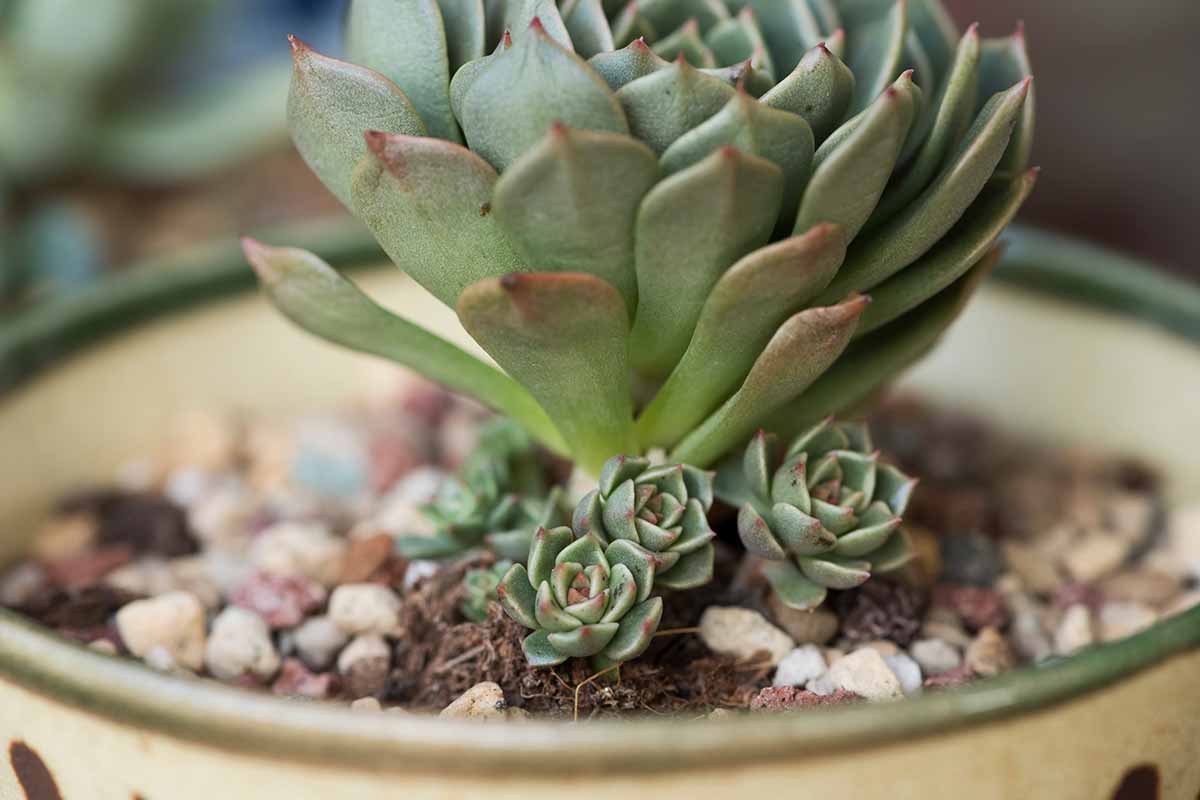
To propagate offsets, remove them from the mother rosette by gently teasing them away with a small trowel or fork.
Pot up in small containers filled with cacti and succulent potting soil and place in bright, indirect light until established.
Water modestly, keeping the soil barely moist and allowing the surface to dry between applications.
Offsets should begin rooting in two to three weeks.
For cuttings, gently remove a lower leaf by shifting it from side to side until it releases from the mother.
Place the leaf on top of the soil in a small two- to four-inch container filled with a succulent soil mix.
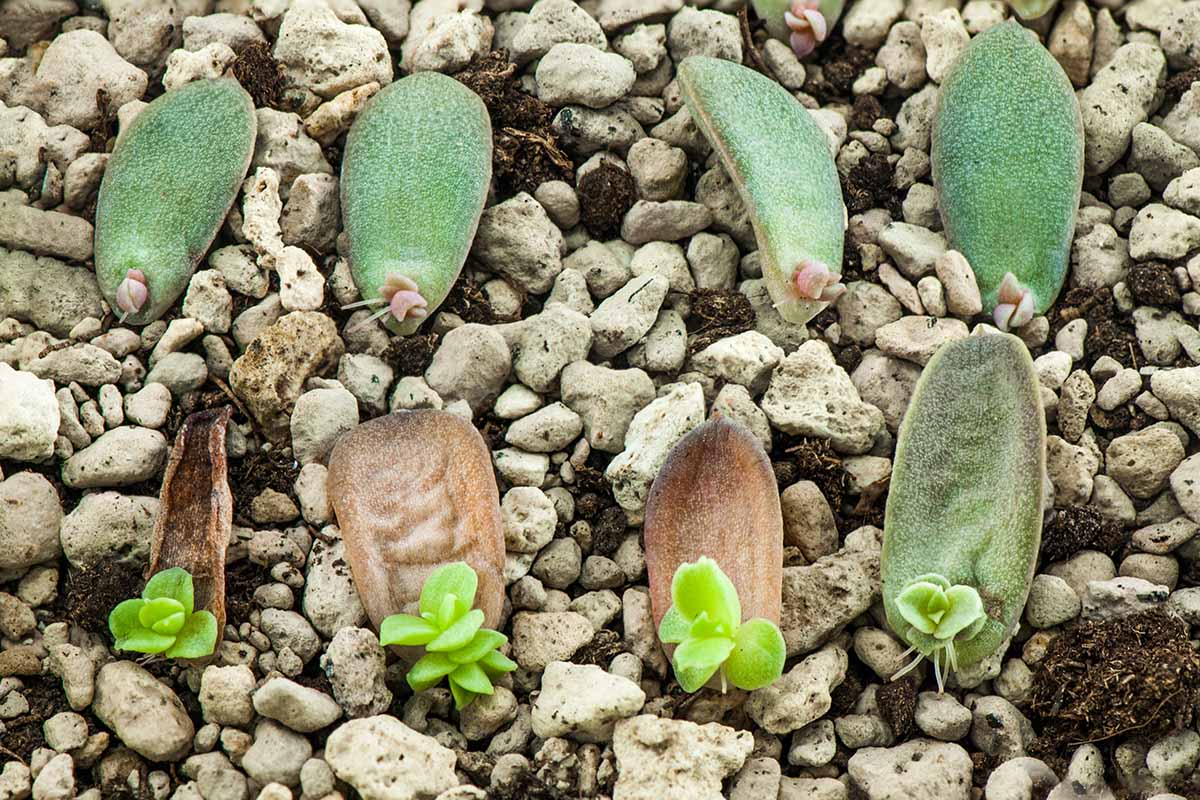
Place in bright, indirect light but don’t water until new roots have developed, usually in two to three weeks.
Allow the leaf to gradually dry out and crumble away on its own – don’t pull at it as the offset roots are easily disturbed.
Once rooting is well established, plant out or pot up and place in a location with bright, indirect light.
To prevent sunburn, allow cuttings and offsets to harden off for two or three weeks in indirect light before placing in full sun.
How to Grow Echeveria
To thrive, echeveria needs well-draining, porous soil with a slightly acidic pH of 6.0 in a full sun location.
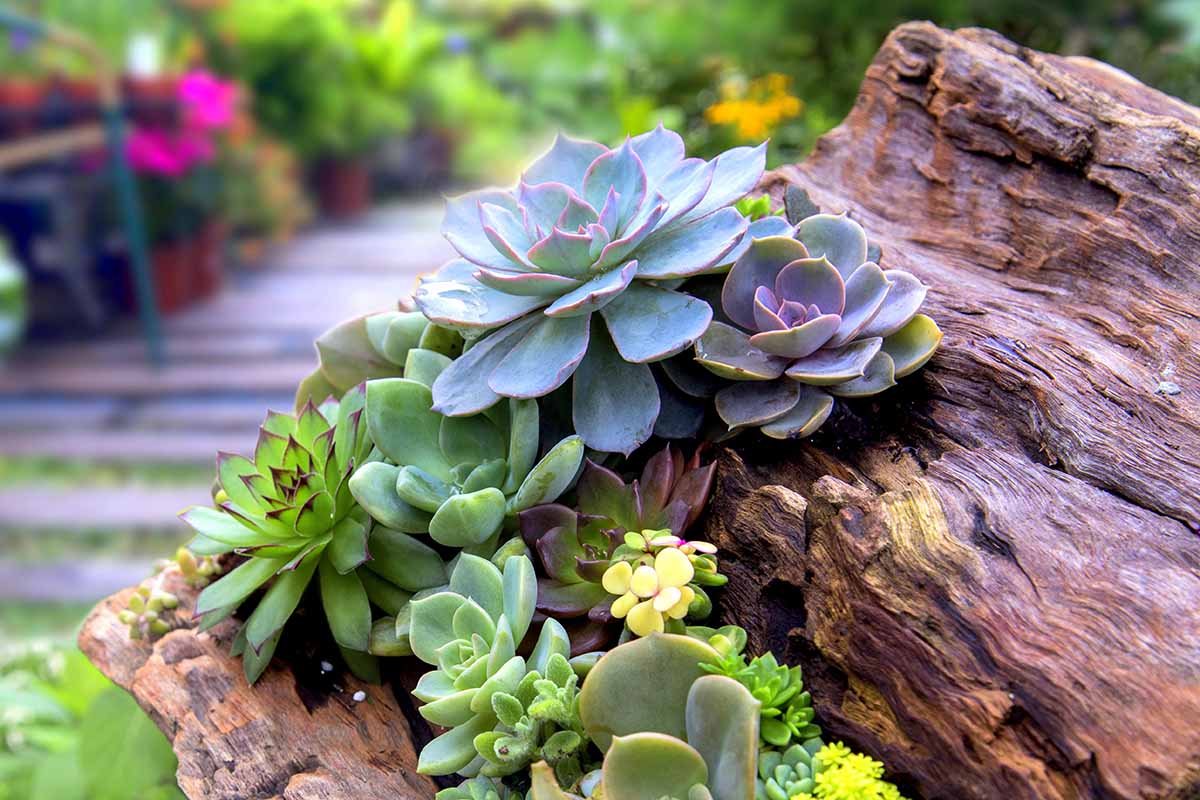
These plants need dry conditions and they can develop fungal infections in high humidity, excess rain, and wet soil. And some varieties may benefit from light shade to protect them from intense afternoon sun.
Fill containers with cactus potting mix, or work it into garden beds to a depth of six to eight inches.
Or create your own blend using one part porous materials like perlite, two parts sand for drainage, and two parts of organic matter for nutrients and a lofty tilth – this guide has our recipe to make your own potting soil for succulents.
Create a shallow planting site and nestle the roots in place so that the crown is at or just below the soil line. You want to avoid having the lower leaves sitting on the soil.
Water gently to settle in place if the soil is very dry.
These desert charmers are easy to grow, but care must be taken to avoid overwatering.
They have shallow roots designed to quickly absorb water and can’t survive in wet soil, which quickly leads to issues like root rot.
And although they’re highly drought tolerant, they still require regular applications of water for the best performance.
In garden beds, allow the soil to dry thoroughly between water applications.
In containers, aim to keep the soil barely moist during the growing season, watering slowly and deeply during hot, dry conditions and allowing the top one to two inches of soil to dry out between applications.
Also, water carefully and don’t allow excess water to sit in the center of rosettes – this mars the waxy outer cuticle and can cause soft tissue rot.
For container plants, choose unglazed pots with large drainage holes in the bottom – terra cotta and unglazed ceramic pots help to soak up excess moisture, protecting the roots from overwatering.
I like to add a layer of pebbles over the holes to ensure the soil drains freely, then fill with a succulent soil blend.
Catchment saucers under potted plants should be promptly emptied of water so it isn’t reabsorbed into the soil.
Indoor Plants
To grow indoors year-round, echeveria requires bright light, preferably with direct sunlight in the morning – a south- or west-facing window is perfect.
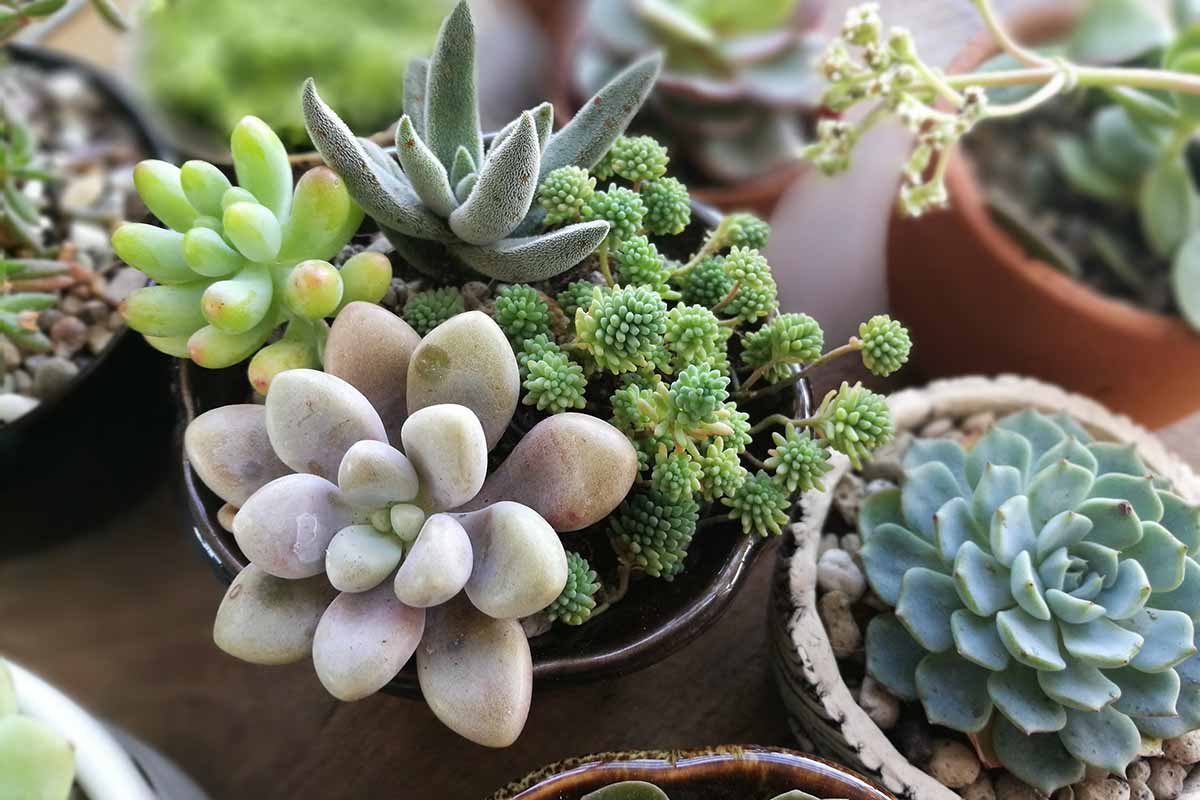
In spring and summer they do best with eight to 12 hours of light, and in winter six hours of bright light is required to keep their rosettes compact.
If you don’t have enough natural light available, consider adding a grow light to prevent plants from stretching out due to low light.
Keep the soil barely moist in spring and summer but allow it to dry out completely between water applications in winter.
Fertilize as outlined in the Pruning and Maintenance section below.
Most echeveria plants don’t require frequent repotting, but if they do become overcrowded, replant in spring into a container that’s two to four inches larger in diameter.
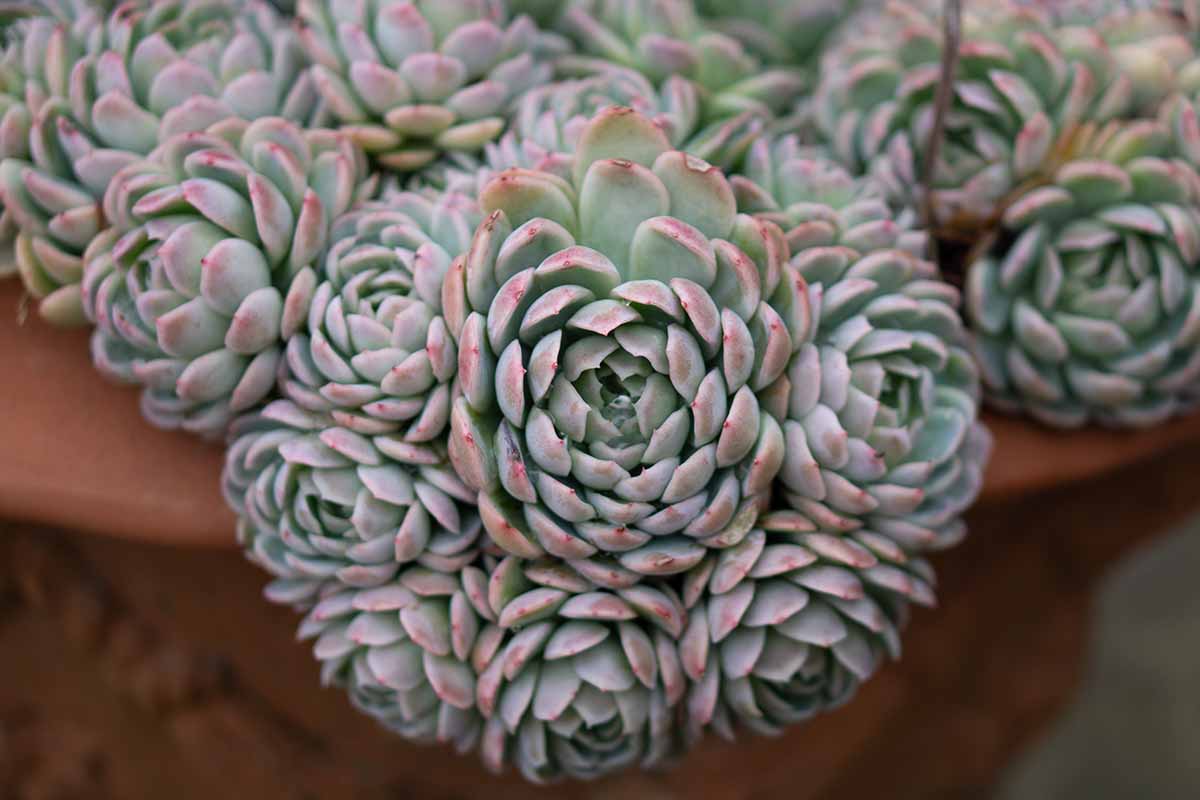
Add a layer of small pebbles over the holes to improve drainage if desired and fill with fresh succulent potting soil.
Wait until the soil is completely dry then gently remove and transplant with a small trowel, keeping the rootball intact.
Water gently but deeply to settle.
Growing Tips
These easy-care plants require little upkeep or attention, with the biggest issues coming from overwatering.
- Choose containers or planting sites in full sun with excellent drainage.
- If you’re unsure of when or how frequently to water, wait until the leaves just begin to shrivel. After watering they’ll quickly bounce back, and they can handle underwatering far better than overwatering.
- If your garden plants need to come indoors for winter, plant them in containers instead of beds – it’s much faster than lifting and transplanting them in fall, and less stressful for the plants.
These succulent evergreens can take some neglect, but a little care helps them to shine.
Pruning and Maintenance
Echeverias rarely require pruning but the flower stems should be cut back close to the base after flowering is finished.
And any damaged growth, or bottom leaves that eventually die off, can be snipped and removed as needed.
Should your plants grow leggy from a lack of sun, they can be topped to encourage new growth along the stem. Prune in spring at the start of the growing season.
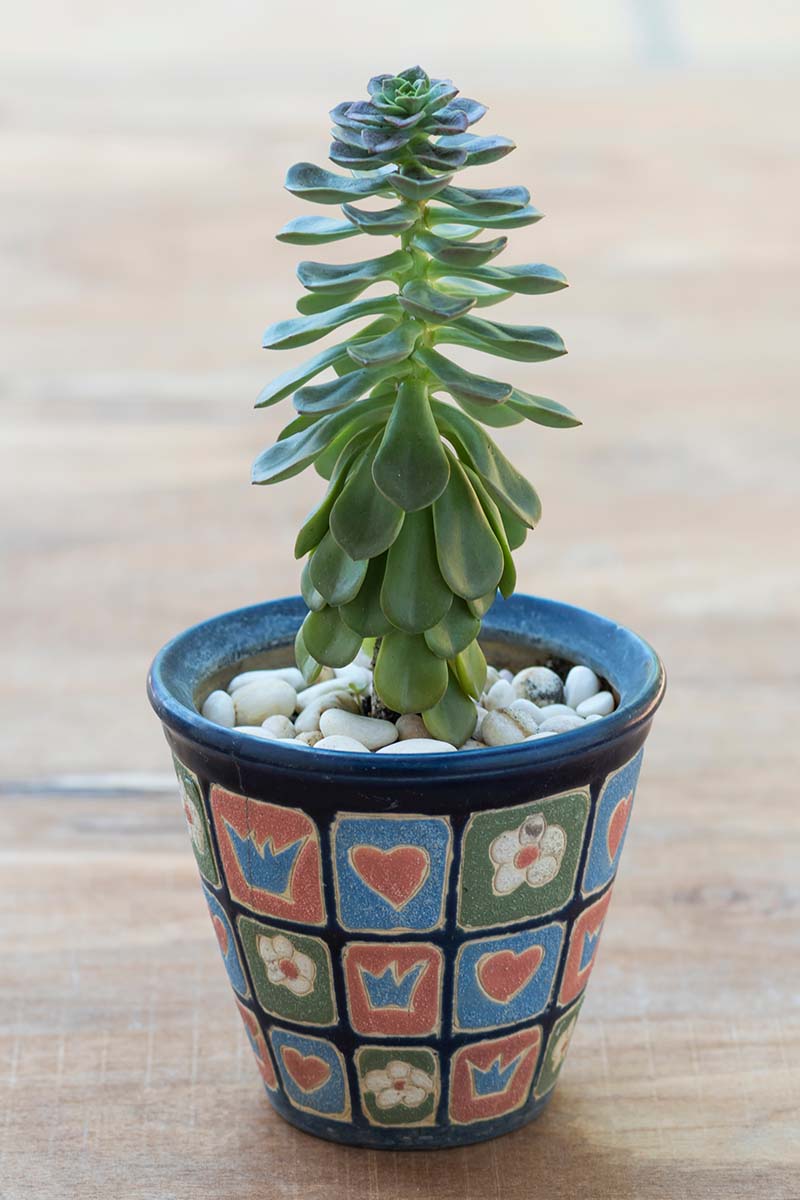
Use clean, sharp garden shears to reduce the stem to a more attractive height, cutting just above a set of leaves, then move plants into a sunny location.
And don’t toss the topped part – use it to propagate new plants.
Although they’re not heavy feeders, echeveria can benefit from a twice yearly application of fertilizer in spring and fall.
To fertilize, use a quarter-strength application of a low-nitrogen formula or one that’s designed for cacti and succulents.
Dr. Earth Succulence Plant Food
Dr. Earth Succulence Cactus & Succulent Plant Food has a 1-1-2 NPK formula and is available at Arbico Organics.
Echeverias are not cold hardy, and they don’t cope well with hail or wet conditions either.
If you have dry, warm winters within their hardiness range, they can be left outdoors in beds or containers.
If your winters are wet and warm, they may survive in soil with excellent drainage, but excess water tends to mar and damage the waxy leaves and causes soft tissue rot.
For rain protection, transplant bedding plants into pots and move containers into a sheltered site, such as under eaves, on a porch, or in a carport.
In areas where they might get frost nipped, cover them with an old sheet or floating row cover fabric.

Most species are frost tender. Grown outside of their hardiness range, they should be moved into a cool, dry environment for the winter. Bring indoors when temperatures drop to 55°F.
If needed, pot up garden plants to move indoors, cleaning plants of any dead or damaged foliage and checking for insects first.
Place in a location that gets a few hours of bright light each day. Echeveria goes dormant over winter and prefers a cool room in the range of 50 to 65°F.
Water sparingly once a month, but only after the soil has thoroughly dried.
In spring after all danger of frost has passed, move them back outdoors and harden off in dappled sun for seven to 14 days before moving into a full sun location.
Echeveria Species and Cultivars to Select
There are a vast array of varieties to choose from in multiple colors, shapes, and sizes. Here are some favorites to start you out.
Blue Curls
Notable for its wavy leaves, ‘Blue Curls’ (E. gibbiflora x) is beautifully colored with fleshy blue green leaves edged in pink, plum, or scarlet that deepens in color during spring and fall.
Spires of flowers in hot pink to orange develop from a single rosette that grows up to 12 inches tall and wide – a fascinating look for containers, tabletop planters, and fairy or succulent gardens.
Container plants are available at Walmart.
Doris Taylor
Also known as wooly rose, E. pulvinata x ‘Doris Taylor’ is delightful with its fuzzy, thick leaves of silvery sage green and bold, spiked clusters of orange and yellow flowers.
Plants grow three to five inches tall with a diameter of up to eight inches and make a handsome choice for carpet bedding in borders, containers, and wreath arrangements.

Two- or four-inch rooted plants are available from the Succulents Box store via Amazon.
Elegans
A classic in succulent gardens, E. elegans showcases beautifully formed rosettes of frosty sage green leaves.
In summer tall flower stems are covered in small tubular flowers, scarlet red at the base with sunshine yellow tips.
Growing six to eight inches tall and wide, this species produces small offsets and makes an elegant choice for containers, ground covers, and rock gardens.
Container plants are available at Nature Hills.
Perle Von Nurnberg
Striking for its soft pastel coloring, ‘Perle Von Nurnberg’ (E. gibbaflora ‘Metallica’ x E. potosina) features rosettes of frosted aqua gray with tones of pink and plum that deepen in full sunlight.
Multiple flower spires develop inflorescences of tubular flowers with a coral pink exterior and bright yellow interior.
For a subtle but dramatic statement, mass plant in borders, containers, living walls, or gravel gardens. The ample rosettes grow up to 10 inches tall with a width of eight inches and produce multiple offsets.
Small plants in 2.5-inch pots are available from Hirt’s Gardens via Walmart.
Truffles
A true charmer with wavy, cabbage-like leaves in cool shades of icy blue to frosty plum, E. shaviana ‘Truffles’ has tall wands of peachy-pink flowers that bloom in the summer’s heat.
Plants reach a mature height of four to six inches with generous six- to eight-inch rosettes that work well in containers, rockeries, and water-wise gardens.
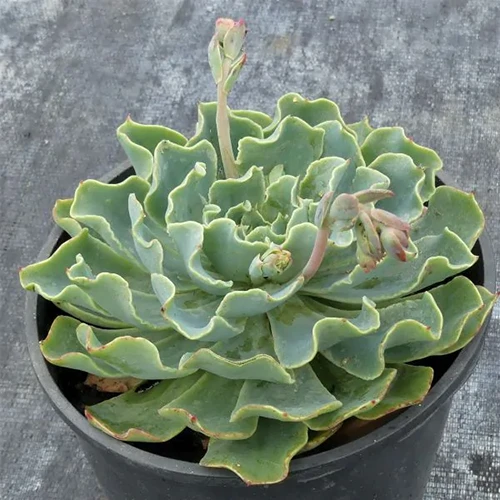
‘Truffles’ is available at Nature Hills.
Looking for More Options?
Be sure to check out our supplemental guide, “27 of the Best Echeveria Varieties.”
Managing Pests and Disease
Echeveria are largely pest free, but sapsuckers like spider mites and mealybugs can present themselves.
Spider mites look like teensy spiders and string white webs between and underneath leaves. They show up in hot, dry conditions and can cause white spots, yellowing, or discolored leaves that eventually drop off.
Mealybugs look like little white chitons on the foliage and prefer warm, humid environments. They also cause leaves to curl, yellow, and drop off.
Both pests can be dispatched with garden-friendly beneficial bugs like ladybugs or predatory wasps, or horticultural soap can be applied to combat persistent infestations.
Fungal issues like root rot and soft tissue rot occur and spread in humid or wet conditions. Check out our guide to managing rot in succulents for more information.
To avoid rot problems, ensure plants are spaced for ample air circulation in high-humidity regions. And it’s essential to plant in well-draining soil and avoid overwatering.
Best Uses
The huge variety of echeveria cultivars makes them suitable for many settings, and they’re particularly effective in massed groupings.

They can be planted on their own or mixed with cacti and other succulents to add unique color and interest to water-wise borders, carpet bedding schemes, containers, and fairy, gravel, rock, xeriscape, or zen gardens.
They also make an excellent tabletop accent or centerpiece and add a distinctive touch to terrariums, living walls, and wreaths.
Quick Reference Growing Guide
| Plant Type: | Perennial succulent | Flower/Foliage Color: | Blue-green, chartreuse, gray-green, green, burgundy, lilac, scarlet, plum/orange, peach, pink, red, white, yellow |
| Native to: | Mexico, Central America, South America | Maintenance: | Low |
| Hardiness (USDA Zones): | 9-12 | Tolerance: | Deer, rodents |
| Bloom Time/Season: | Summer | Soil Type: | Lean, porous, gritty |
| Exposure: | Full sun | Soil pH: | 6.0-7.0 |
| Time to Maturity: | 120 days (seed), up to 4 years (root stock) | Soil Drainage: | Well-draining |
| Spacing: | 2-6 inches, depending on variety | Attracts: | Bees, hummingbirds |
| Planting Depth: | Crown at soil level | Uses: | Containers, living walls, waterwise borders; fairy, rock, xeriscape, or zen gardens |
| Height: | 2-24 inches | Order: | Saxifragales |
| Spread: | 2-12 inches | Family: | Crassulaceae |
| Water Needs: | Low | Genus: | Echeveria |
| Common Pests and Diseases: | Mealybugs, spider mites; root rot, soft tissue rot | Species: | Elegans, gibbiflora, glauca, pulvinata, shaviana |
Desert Delights
With their lovely symmetrical rosettes in icy or burnished colors, plus colorful flower spikes, echeveria is a true desert delight that’s a perfect plant for low-water gardens and xeriscapes!
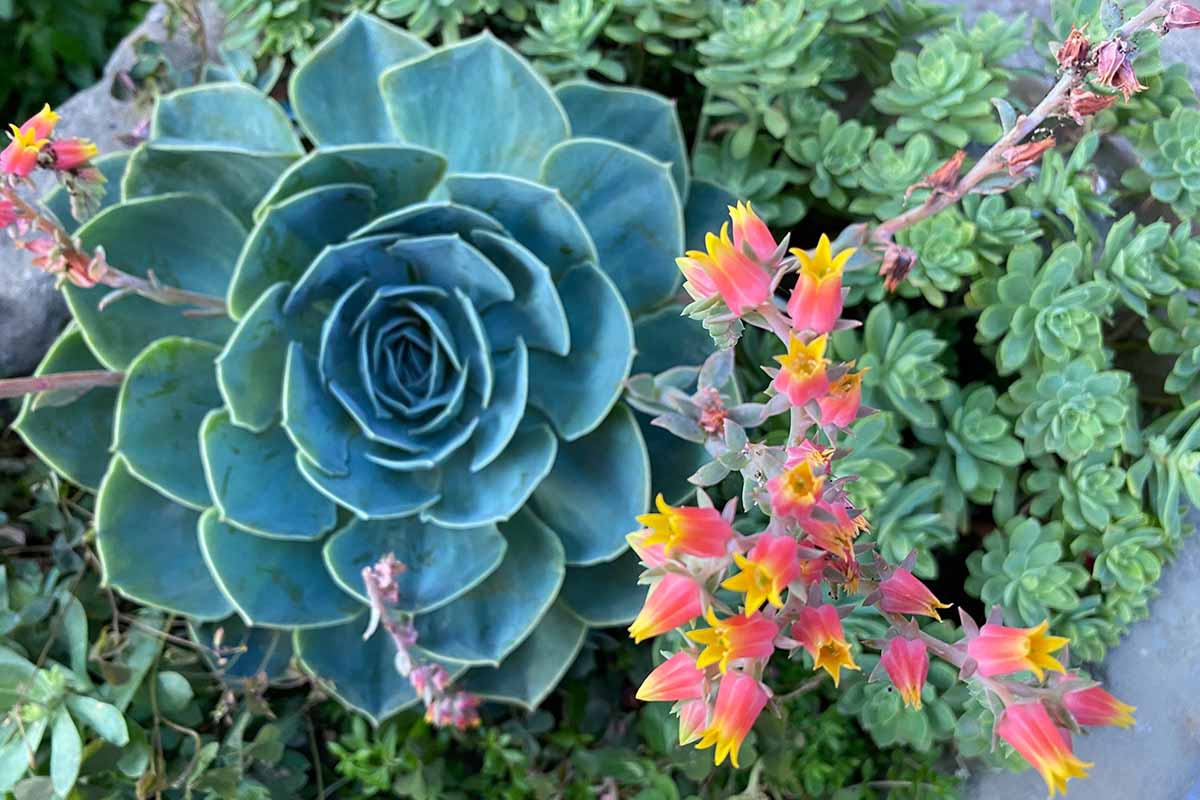
They add unique appeal when massed in borders, planters, or rock gardens, and container cultivation is a fast and easy way to bring these frost-tender sweethearts indoors for winter.
But don’t overdo it with the kindness. With their excellent drought tolerance, hold waaay back on the water because they shine in lean, arid conditions.
Have you folks got a hotspot in need of some echeveria? Where will it go? Tell us about it in the comments section below.
And for more information about growing succulents, check out these guides next:

